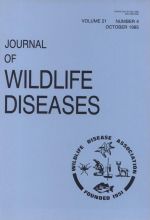A moribund, emaciated California quail (Callipepla californica) that was found in an orchard in the state of Washington had an impacted crop and gizzard. Pellets containing the anticoagulant chlorophacinone (Rozol®, RO) were in the crop; the gizzard contents consisted of a pink mass of paraffin that was selectively accumulated from the paraffinized pellets. The plasma prothrombin time of 28 sec was near that determined for control quail. The signs of RO intoxication seen in the moribund wild quail were duplicated in captive quail given ad libitum diets of either RO or another paraffinized chlorophacinone pellet (Mr. Rat Guard II®, MRG). This left little doubt that paraffin impaction of the gizzard was the primary problem. All captive quail fed RO or MRG pellets showed no increases in prothrombin times compared to control values, died in an emaciated condition, and had gizzards impacted with paraffin.
How to translate text using browser tools
1 October 1985
EFFECTS OF PELLETIZED ANTICOAGULANT RODENTICIDES ON CALIFORNIA QUAIL
Lawrence J. Blus,
Charles J. Henny,
Robert A. Grove





